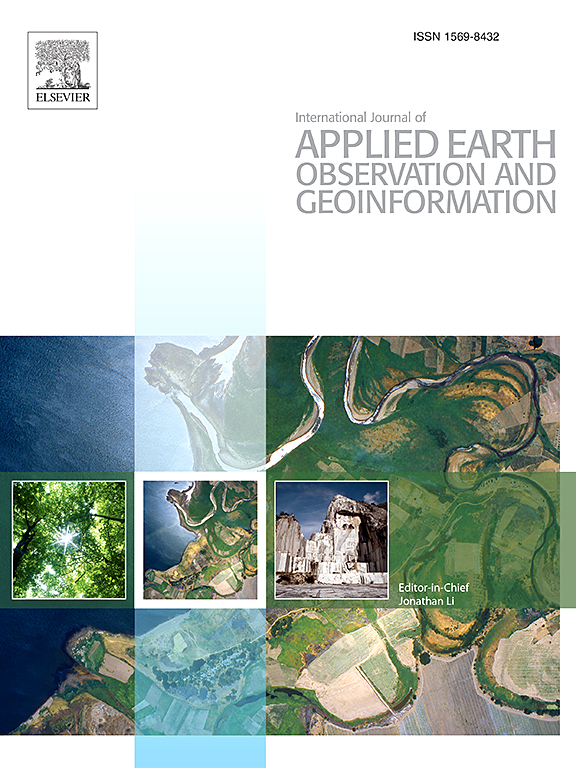MCR-PFNet: A novel InSAR interferometric phase filtering method for complex noise and large gradient deformations
IF 7.6
Q1 REMOTE SENSING
International journal of applied earth observation and geoinformation : ITC journal
Pub Date : 2025-05-26
DOI:10.1016/j.jag.2025.104621
引用次数: 0
Abstract
Phase filtering is crucial for ensuring accurate phase unwrapping in the processing of Interferometric Synthetic Aperture Radar (InSAR) data. Traditional filtering methods often struggle to effectively suppress noise and accurately preserve phase edge information when processing InSAR interferometric phases with complex noise and large gradient deformations. In response to this challenge, we have proposed the MCR-PFNet model based on residual attention convolution for InSAR phase filtering. MCR-PFNet integrates residual blocks, the convolutional block attention module (CBAM), and a multi-head self-attention module, enabling the simultaneous extraction of both local and global phase features, while filtering out noise and preserving phase details. To further enhance the generalization capability of MCR-PFNet, additive Gaussian noise and local phase jumps were introduced into the training dataset, and the MCR-PFNet model was trained with a custom-designed periodic phase loss function. The filtering performance was evaluated on simulated and real datasets. The results demonstrate that MCR-PFNet excels in scenarios with complex noise and large gradient deformations. In the simulated wrapped phase experiments, MCR-PFNet outperformed other methods in three metrics: PSNR (55.820–64.017 dB), SSIM (0.965–0.990), and MSE (0.026–0.170 rad2). In two sets of real data experiments, MCR-PFNet significantly improved the quality of the interferograms. In the real InSAR data of coal mining subsidence, the filtered NOR decreased to 517, PRR reached 86.987 %, and Metric Q reached 95.278 %. In the real InSAR data of earthquakes, NOR was reduced by 4.016 %–79.997 % compared to other methods, while PRR and Metric Q increased by 0.116 %–25.899 % and 0.111 %–13.803 %, respectively.
MCR-PFNet:一种新的InSAR干涉相位滤波方法,用于复杂噪声和大梯度变形
在干涉合成孔径雷达(InSAR)数据处理中,相位滤波是保证相位展开精度的关键。传统滤波方法在处理噪声复杂、梯度变形大的InSAR干涉相位时,往往难以有效抑制噪声并准确保留相位边缘信息。针对这一挑战,我们提出了基于残差注意卷积的MCR-PFNet模型用于InSAR相位滤波。MCR-PFNet集成了残差块、卷积块注意模块(CBAM)和多头自注意模块,能够同时提取局部和全局相位特征,同时滤除噪声并保留相位细节。为了进一步提高MCR-PFNet的泛化能力,在训练数据集中引入加性高斯噪声和局部相位跳变,并使用定制的周期相位损失函数对MCR-PFNet模型进行训练。在模拟数据集和真实数据集上对滤波性能进行了评价。结果表明,MCR-PFNet在复杂噪声和大梯度变形情况下表现优异。在模拟包裹相位实验中,MCR-PFNet在三个指标上优于其他方法:PSNR (55.820 ~ 64.017 dB)、SSIM(0.965 ~ 0.990)和MSE (0.026 ~ 0.170 rad2)。在两组实际数据实验中,MCR-PFNet显著提高了干涉图的质量。在采煤沉陷真实InSAR数据中,滤波后的NOR降至517,PRR达到86.987%,Metric Q达到95.278%。在InSAR真实地震资料中,NOR比其他方法降低了4.016% ~ 79.997%,而PRR和Metric Q分别提高了0.116% ~ 25.899%和0.111% ~ 13.803%。
本文章由计算机程序翻译,如有差异,请以英文原文为准。
求助全文
约1分钟内获得全文
求助全文
来源期刊

International journal of applied earth observation and geoinformation : ITC journal
Global and Planetary Change, Management, Monitoring, Policy and Law, Earth-Surface Processes, Computers in Earth Sciences
CiteScore
12.00
自引率
0.00%
发文量
0
审稿时长
77 days
期刊介绍:
The International Journal of Applied Earth Observation and Geoinformation publishes original papers that utilize earth observation data for natural resource and environmental inventory and management. These data primarily originate from remote sensing platforms, including satellites and aircraft, supplemented by surface and subsurface measurements. Addressing natural resources such as forests, agricultural land, soils, and water, as well as environmental concerns like biodiversity, land degradation, and hazards, the journal explores conceptual and data-driven approaches. It covers geoinformation themes like capturing, databasing, visualization, interpretation, data quality, and spatial uncertainty.
 求助内容:
求助内容: 应助结果提醒方式:
应助结果提醒方式:


